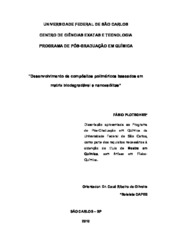Desenvolvimento de compósitos poliméricos baseados em matriz biodegradável e nanozeólitas
Abstract
The current market demands make with what Brazilian agribusiness search improvements in processes and new materials to reduce waste, pollution and biological contamination. Mainly materials that more are easily degraded by the action of microorganisms or abiotic factors.It is known that the synthetic plastics are difficult of degrade and one alternative to decrease their use and hence the contamination of the environment is the introduction of biodegradable plastics such as thermoplastic starch (TPS). Thus, this study aimed to develop nanocomposites of TPS, seeking conditions for the incorporation of nanozeólitas (ZSM-5) that could confer properties related to control hydrophilicity. The work started in the construction of hydrothermal reactors for the standardization of zeolite. The synthesis gel was based on a molar ratio has been already studied (Al2O3: 60SiO2: 11TPAOH: 900H2O). The hydrothermal treatment was done in five different ways, varying temperatures (100, 150 and 200oC) and time (24, 48 and 72 hours). The five samples were characterized by X-ray diffraction, nitrogen physisorption, particle size analysis by light scattering and scanning electron microscopy at high resolution. The best condition of formation of zeolite phase was 200oC for 24 hours. This synthesis was repeated and characterized by four times to obtain 27g of nanozeólitas to be used to obtain the composite processing. The compositions of thermoplastic starch and nanozeólita were made in a torque rheometer with mass ratios of 0, 2, 4, 6, 8 and 10% ZSM-5 TPS, keeping fixed the final mass of the mixture, 45 g. Thermogravimetric analysis of films showed that the increased load of nanozeolites in the matrix polymer no caused change in the temperatures of the events that occur in the mass losses. The results of dynamic mechanical thermal analysis showed no significant variations in glass transition temperatures of the glycerol and starch, which were influenced by the increase of ratio glycerol / starch. The analysis of tensile mechanics showed that up to 6% zeolite added there is no impairment of mechanical properties of films, above this value occurs a lower elastic modulus of the composite and consequently an increase in the deformation of the material also caused by variations in the relationship between ratio glycerol and starch. Statistical analysis of variance for this experiment confirmed the previous supposition. The pervaporation water vapor showed that the increased load of zeolite in the polymer matrix facilitated the passage of water through the polymer matrix due to the presence of the channels characteristic of the zeolite. Statistical analysis of variance showed that the most significant change was the 10% zeolite added. Through these studies we can see that it is possible to incorporation of zeolite in thermoplastic starch using the same equipment used in processing of synthetic plastics. This study also showed that the incorporation of zeolite modified the hydrophilicity of the material facilitating the passage of water vapor by the matrix polymer by channels of zeolite.
